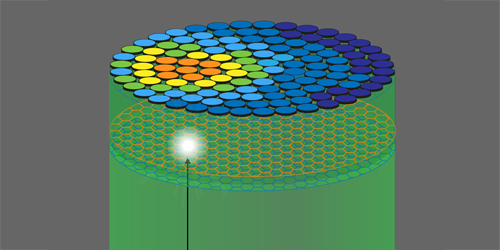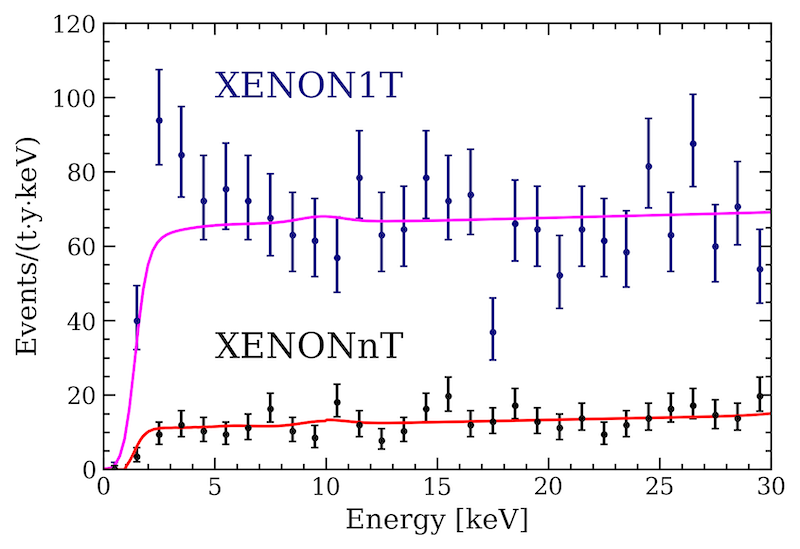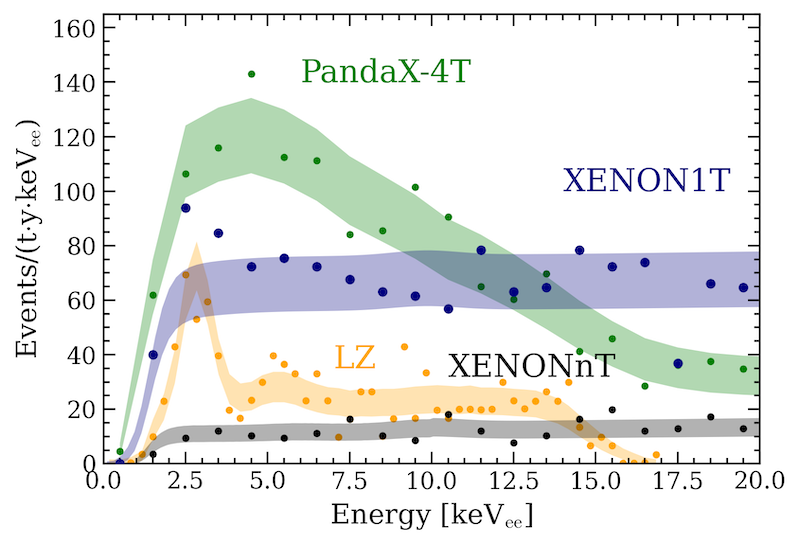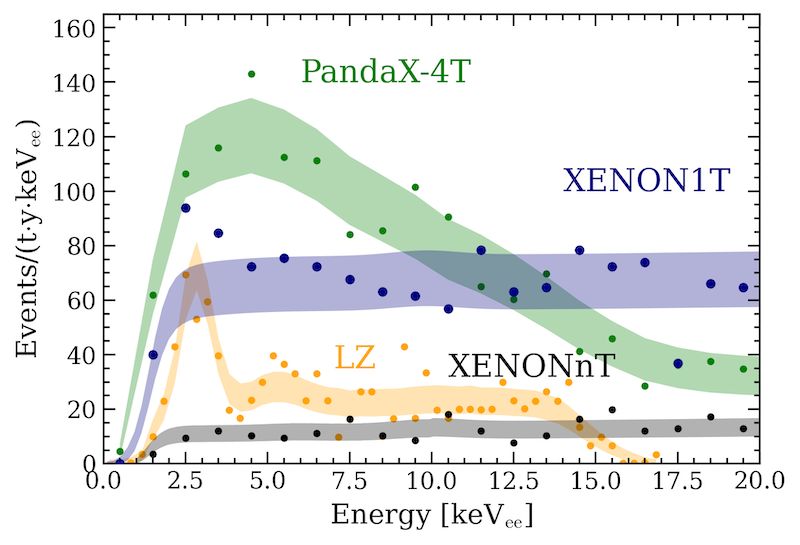Potential Dark Matter Signal Gives Way to New Limits
There is overwhelming evidence that dark matter makes up most of the matter in the Universe—researchers have even mapped its distribution on cosmic scales by observing how it stretches the images of distant galaxies. But we still don’t know what dark matter is. This unresolved puzzle is being tackled by direct-detection experiments that continue to break record after record with their sensitivities to feeble particle interactions. Today two leading dark matter searches—the XENON experiment under the Gran Sasso massif in Italy and the PandaX experiment at the China Jinping Underground Laboratory, the world’s deepest laboratory—publish analyses of their latest runs.
Reporting what Big Think called one of the best “null result” in history, XENON shows that a tantalizing signal reported in 2020 was due to background noise rather than to new physics and sets stringent limits on various dark matter types that had been invoked to explain such a signal [1]. The PandaX Collaboration performed a similar measurement, also detecting no events over the expected background [2]. The collaboration used its null result to derive the tightest constraints to date on properties of a type of dark matter called light fermionic dark matter.
Experiments such as XENON and PandaX use huge tanks of purified liquid xenon, searching for free electrons and photons produced when a dark matter particle hits a particle in the detector—causing an atomic nucleus or an electron to recoil. Both experiments have successively boosted their sensitivities by increasing the amount of xenon in the tank, with current iterations of XENON (XENONnT) and of PandaX (PandaX-4T) using about 6 and 4 tons of liquid xenon, respectively. The sensitivity boost also relies on huge efforts to minimize background noise that could look like a signal. In today’s experiments, the dominant backgrounds come from traces of radioactive isotopes in the setup or in the environment.
Both XENON and PandaX are chiefly focused on the search for the leading dark matter candidate—the weakly interacting massive particle (WIMP)—whose mass should exceed 10 GeV/c2. WIMPs are expected to mostly scatter off atomic nuclei, producing a characteristic nuclear recoil signal. However, dark matter scientists can look for other signals—such as electron recoils—that may come from non-WIMP dark matter (see Feature: WIMP Alternatives Come Out of the Shadows).
In June 2020, XENON1T, XENONnT’s smaller predecessor, delivered an attention-grabbing result—recording more electron recoil events than those expected from known backgrounds (see Viewpoint: Dark Matter Detector Delivers Enigmatic Signal). The results spurred a flurry of theoretical studies exploring whether new particles—including nonstandard neutrinos, light bosonic dark matter particles, and solar axions—could explain the excess signal. XENON researchers, however, acknowledged uncertainties about the impact of the background due to tritium isotopes. Just a handful of tritium atoms per kilogram of xenon could have explained the observed signal.
XENONnT has now delivered remarkably improved data that don’t show any excess signal. The improvement is mostly owing to the tripling of the xenon volume and to several background reduction measures. In particular, the researchers reduced the likelihood of introducing tritium into the experiment by outgassing the detector prior to the run and by passing the liquid xenon through units that remove hydrogen (and its isotopes, including tritium).
Jingqiang Ye of Columbia University, data-analysis coordinator for the XENON Collaboration, says that XENONnT’s results put to rest the idea that XENON1T might have spotted dark matter. “We will never know for sure what caused the XENON1T excess, but we now know that it is not new physics,” he says.
The PandaX-4T Collaboration scrutinized electron-recoil signals in the same energy range as XENONnT. The team also found no hints of excess events, although the experiment has a much larger background at the energies of the XENON1T excess (mostly due to leftover tritium introduced in the setup for calibration, which the team is gradually removing). The researchers, however, sifted their data for specific signatures of a fermionic dark matter particle with a mass between 10 and 180 keV/c2. The search for this type of light dark matter was motivated by recent theoretical work suggesting that these particles might be absorbed by electrons, producing observable signals in direct-detection experiments.
PandaX found no such signals and used the nondetection to set limits on the strength of the coupling between light fermionic dark matter and electrons. The analysis focused on dark matter whose interactions with electrons are described by certain operators (called vector and axial-vector operators). “We chose these interactions because they are very loosely constrained by astrophysical and cosmological observations,” says Dan Zhang of the University of Maryland, College Park. This choice allowed the collaboration to set the strictest bounds to date for the strengths of these interactions, she says. (In a separate study, PandaX searched for a related signal from light fermionic dark matter interacting with atomic nuclei; see Synopsis: An Absorbing Dark Matter Experiment.)
The fact that researchers were able to so quickly test and rule out the XENON1T excess signal is a success of the scientific method, says Hugh Lippincott of the University of California, Santa Barbara—spokesperson for LUX-ZEPLIN (LZ), a 7-ton xenon-based dark matter experiment in the Sanford Underground Research Facility in South Dakota, which just released results from its first WIMP search. With continued improvements over the next few years, XENON, PandaX, and LZ will “dig into a whole new region of the parameter space [for dark matter],” he says. And a further scale-up is in the works: XENON and LZ researchers have recently agreed to join forces to build an order-of-magnitude larger detector.
Lippincott adds that “with that much xenon in a very quiet space,” researchers could study many interesting things besides dark matter, including neutrinos and extremely rare processes. XENON1T already demonstrated such capabilities by measuring an electron capture process whose lifetime exceeds the age of the Universe by many orders of magnitude. Ye agrees that the ultrasensitive detectors may “see” things that are different from those they were built to detect. He says, quoting physicist Freeman Dyson, that new directions in science are more often launched by new tools than by new concepts.
–Matteo Rini
Matteo Rini is the Editor of Physics Magazine.
References
- E. Aprile et al. (XENON Collaboration), “Search for new physics in electronic recoil data from XENONnT,” Phys. Rev. Lett. 129, 161805 (2022).
- D. Zhang et al. (PandaX Collaboration), “Search for light fermionic dark matter absorption on electrons in PandaX-4T,” Phys. Rev. Lett. 129, 161804 (2022).








